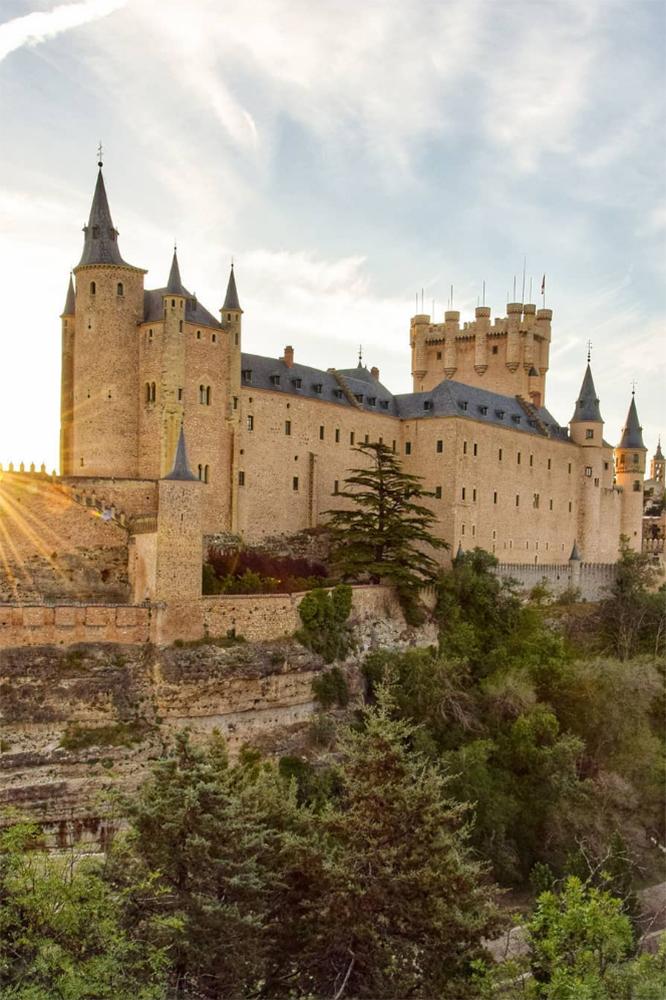The Alcázar de Segovia is a breathtaking medieval fortress located in the historic city of Segovia, Spain. Perched atop a rocky promontory at the confluence of two rivers, the castle’s imposing silhouette dominates the city skyline and offers panoramic views of the surrounding countryside.
Architectural Marvel: The Alcázar de Segovia is renowned for its stunning architecture, blending elements of Moorish, Romanesque, and Gothic styles. Its distinctive profile, with soaring turrets, crenellated walls, and a central keep, reflects its strategic importance as a defensive stronghold and royal residence.
Royal Residence: Throughout its history, the Alcázar served as a royal palace for various Spanish monarchs, including King Ferdinand II and Queen Isabella I. The castle’s interior features lavish rooms, ornate furnishings, and impressive works of art, offering visitors a glimpse into the opulent lifestyle of the Spanish royalty.
Historical Significance: The Alcázar de Segovia has played a significant role in Spanish history, serving as a symbol of royal power and prestige. It was here that Queen Isabella was proclaimed queen of Castile in 1474, marking the beginning of her reign alongside King Ferdinand and the unification of Spain.
Military Fortress: As a military fortress, the Alcázar de Segovia was designed to withstand sieges and attacks. Its strategic location, perched high above the surrounding terrain, provided a natural defense against would-be invaders. Visitors can explore the castle’s defensive features, including its fortified walls, towers, and moat.
Cultural Icon: The Alcázar de Segovia is not only a UNESCO World Heritage Site but also a cultural icon that has inspired artists, writers, and filmmakers for centuries. Its picturesque setting and rich history have been depicted in countless works of art, literature, and cinema, contributing to its enduring legacy as one of Spain’s most beloved landmarks.
Tourist Destination: Today, the Alcázar de Segovia is a popular tourist destination, welcoming visitors from around the world to explore its magnificent architecture and learn about its fascinating history. Guided tours, exhibitions, and cultural events offer visitors a deeper understanding of the castle’s significance and its role in shaping Spain’s cultural heritage.
Overall, the Alcázar de Segovia stands as a testament to Spain’s rich history and architectural heritage, attracting visitors with its beauty, grandeur, and historical significance. A visit to this majestic fortress is a journey back in time, offering a glimpse into the storied past of one of Europe’s most enchanting castles.
Influences and Architecture: The Alcázar’s architectural style reflects a blend of influences from different periods and cultures. While its origins date back to the 12th century, the castle underwent significant renovations and expansions over the centuries, resulting in a unique combination of Romanesque, Gothic, and Mudejar (Moorish) elements. The castle’s diverse architectural features, including its pointed arches, intricate carvings, and horseshoe arches, showcase the cultural diversity of medieval Spain.
Aqueduct Views: One of the most striking features of visiting the Alcázar de Segovia is the panoramic view of the city, including the iconic Roman aqueduct. From the castle’s elevated position, visitors can admire the impressive engineering feat of the aqueduct, which stretches across the valley and has been a symbol of Segovia for over two millennia.
Legends and Myths: Like many ancient castles, the Alcázar de Segovia is steeped in legend and folklore. One famous legend tells the story of the castle’s design being inspired by the shape of a ship, leading to its nickname as the “ship of stone.” Another legend involves the story of Princess Urraca, whose ghost is said to haunt the halls of the castle.
Connection to Walt Disney: The Alcázar de Segovia is often cited as one of the inspirations for the iconic Disney Cinderella Castle. The castle’s picturesque appearance, with its distinctive turrets and fairy-tale-like setting, is reminiscent of the romanticized castles featured in Disney films. This connection has further enhanced the castle’s global recognition and appeal.
Cultural Events and Festivals: Throughout the year, the Alcázar de Segovia hosts various cultural events and festivals that celebrate the region’s heritage. These events may include medieval reenactments, music concerts, and art exhibitions, providing visitors with opportunities to immerse themselves in the castle’s history and ambiance.
Preservation Efforts: Preservation efforts are ongoing to ensure the conservation and restoration of the Alcázar de Segovia for future generations to enjoy. These efforts include maintenance of the castle’s structure, conservation of its artwork and artifacts, and research into its historical significance. By preserving the castle’s cultural heritage, these initiatives contribute to its continued status as a symbol of Spanish history and identity.
These additional aspects further highlight the richness and significance of the Alcázar de Segovia as a cultural treasure and architectural masterpiece.

